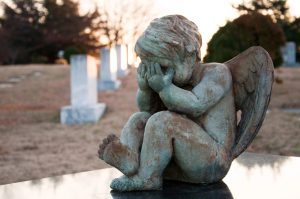I. Introduction
The interplay between fear and grief profoundly shapes human experiences, particularly in the face of loss and profound change. Fear often emerges as a natural response to the unknown, exacerbating feelings of grief and complicating the grieving process. For instance, studies indicate that when individuals are confronted with traumatic events such as stillbirth, emotional distress may surface as a result of fear surrounding their ability to cope and manage their loss ((A Lathrop et al., 2015)). Similarly, an HIV diagnosis can catalyze a spectrum of emotional turmoil, leading to significant psychological disruption that hinders effective self-management and care ((Derose et al., 2019)). Understanding how these dual elements—fear and grief—affect individuals ability to navigate their emotional landscapes is crucial. This exploration illuminates the need for tailored support systems that address these intertwined phenomena, enabling those affected to reconcile their emotions and foster resilience in the face of adversity.
Fear can play a large role in inhibiting adaptation and resiliency in grief. Grief counselors can help individuals identify fears and find the necessary skills to help individuals adjust despite the fears associated with the loss.
A. Definition of fear and grief
Fear and grief, while distinct emotional experiences, are intricately connected and serve as fundamental responses to loss and uncertainty. Fear often arises in the face of potential threats, whether they stem from external situations or internal anxieties about life, death, and the unknown. This emotional state can intensify when individuals confront significant life changes, such as severe illness, which challenges their perceptions of security and hope ((Kissane et al., 2018)). In contrast, grief manifests as a profound sorrow associated with the absence of someone or something cherished, encapsulating not just the loss itself but also the myriad feelings that accompany it. For instance, the use of victim impact statements in death penalty cases illustrates how grief can polarize emotions, as mourning relatives navigate their pain while the justice system attempts to mediate retribution. Ultimately, both fear and grief highlight the human struggle to find meaning and resolution in the face of lifes inevitable uncertainties ((Bandes et al., 2008)).
Ultimately, it is natural to fear loss and pain. Fear is an emotion that reacts to things that are not good in life. It is OK to fear loss. It is OK to feel uncomfortable discussing it but it is important to not allow fear to cripple oneself from facing loss and discussing it. Avoidance of loss and grief due to fear can lead to lost moments of expressing truth and love to others while we still have them. It is hence important to discuss the uncomfortable despite the fear. But it is equally important to understand that fear is OK when it comes to thinking about unpleasant things.
B. Importance of understanding these emotions
Comprehending the emotions of fear and grief is crucial, particularly as they can profoundly shape an individuals psychological wellbeing. The experience of fear, often intertwined with grief, can emerge in various contexts, such as the loss of a loved one, where the bereaved may grapple with feelings of helplessness and insecurity about the future. Understanding these emotions not only aids in recognizing the complex nature of grief but also allows for the development of effective support systems tailored to individuals needs. For instance, children mourning the loss of a sibling often face unique emotional challenges and require acknowledgment of their grief experiences to cope effectively; research indicates that inadequate support can exacerbate these challenges ((A Fujita et al., 2025)). Similarly, individuals coping with miscarriage face a complex emotional landscape that demands understanding and sensitivity, as highlighted by a qualitative study that explores their narratives and grief responses ((H I Lau et al., 2024)). Recognizing the importance of these emotions enables better therapeutic interventions and fosters resilience in those affected by loss.
C. Overview of the relationship between fear and grief
Fear and grief are intrinsically connected, often intertwining to shape an individuals emotional response to loss. Grief, a natural reaction to losing a loved one, can manifest alongside fear, particularly when individuals confront the uncertainty that follows a loss. This uncertainty can induce anxiety about the future and exacerbate feelings of isolation and helplessness. The interplay of these emotions is evident in circumstances where women seek termination of pregnancy, driven by fear of societal pressures and personal circumstances; stressors such as rape or lack of support significantly heighten their mental health challenges, further entrenching their grief (M G S Musabwasoni et al., 2025). Similarly, narratives like that of Bruce Wayne in Matt Reeves The Batman illustrate how fear stemming from childhood trauma can impede healthy grieving processes, leading to maladaptive coping mechanisms (Sinaulan NL et al., 2025). Ultimately, recognizing the symbiotic nature of fear and grief is crucial for facilitating healing and fostering resilience.
II. The Nature of Fear
Fear, an intrinsic human emotion, often emerges in response to perceived threats, encompassing a spectrum from mild apprehension to acute terror. This complexity is particularly evident in the context of grief, where fear can manifest alongside profound loss. Individuals grappling with bereavement may experience eco-anxiety, a specific fear related to environmental degradation and its implications for future generations. Such anxiety is intertwined with feelings of grief, guilt, and despair, as individuals confront the reality of an uncertain world. This interplay is essential to understanding emotional responses; researchers observe that eco-anxiety can serve a constructive role by motivating individuals to engage with pressing global issues ((Ojala M et al., 2021)). Educators and mental health professionals highlight the importance of providing safe spaces for individuals to express these emotions, facilitating resilience and adaptive coping strategies ((Pihkala P, 2020)). Thus, comprehending the nature of fear within the context of grief is vital for fostering emotional well-being.
A. Psychological and physiological responses to fear
The psychological and physiological responses to fear are profound and intricate, significantly impacting individuals ability to cope with trauma and grief. Fear can trigger a range of emotional reactions, often exacerbating feelings of loss and anxiety. As individuals confront existential threats, such as illness or death, their cognitive processing becomes heavily influenced by these emotional states. Emotion modulates attentional resources, making individuals more susceptible to processing relevant experiences linked to their fear, thereby affecting memory formation (Tyng CM et al., 2017). This heightened state of awareness can lead to acute stress responses characterized by increased heart rate and hypervigilance, as individuals grapple with the uncertainties surrounding their grief (Ambrose H Wong et al., 2020). The interplay between these psychological and physiological responses not only complicates the grieving process but also necessitates an understanding of how fear can shape, and often hinder, healing in individuals facing profound loss.
B. Types of fear: rational vs. irrational
Understanding the distinction between rational and irrational fears is crucial in navigating the complex emotional landscape of fear and grief. Rational fears are grounded in reality, often serving a protective function by responding to tangible threats, such as fear of failure that drives an individual to work harder or fear of loss that propels one to cherish relationships more deeply. In contrast, irrational fears, characterized by disproportionate responses to perceived dangers, can lead to crippling anxiety and hinder personal growth. Such fears often stem from deeply rooted psychological factors and can manifest in various ways, paralleling findings in entrepreneurship where emotional states influence decision-making processes (Dean A Shepherd et al., 2018). Furthermore, the interplay of these fears can shape emotional health, as evidenced by the interconnectedness of personality archetypes and their associated emotions in Traditional Chinese Medicine, which can shed light on the origins of irrational fears (Christopher R Chase, 2018). Through this lens, understanding these types of fear becomes essential for emotional recovery and resilience.
C. The role of fear in human survival
Fear serves a critical evolutionary function, acting as an essential mechanism for human survival. By triggering a heightened state of awareness, fear influences cognitive processes, shaping how individuals perceive and respond to threats. This emotional state not only modulates attention but also motivates decisive actions in the face of danger, a response deeply rooted in human evolution. Research indicates that there is a complex interaction between the amygdala, prefrontal cortex, and hippocampus, which collectively facilitate memory consolidation and decision-making during stressful encounters (Tyng CM et al., 2017). Moreover, defining emotions is a nuanced endeavor, yet understanding fears role within that framework can elucidate its importance in survival scenarios (Mulligan K et al., 2012). Ultimately, fear is not merely a psychological response; it is a vital component of the human experience that fosters adaptability, enabling individuals to navigate and respond effectively to life-threatening situations.
III. The Nature of Grief
Grief is an inherently complex emotion, intricately intertwined with various forms of fear and loss experienced throughout life. The nature of grief can manifest in multiple ways, often influenced by personal circumstances and external pressures. For instance, the global impacts of the COVID-19 pandemic have significantly exacerbated mental health challenges, particularly among children and adolescents who face heightened vulnerability during formative years. The confinement and disruptions to daily life commonly lead to increased anxiety, illustrating how grief over lost normalcy intertwines with fear of illness and uncertainty (Samji H et al., 2021). Moreover, contemporary issues such as climate change have given rise to ecological grief, where individuals confront overwhelming anxiety regarding environmental degradation and its implications for the future. This interconnectedness of fear and grief underscores the necessity of fostering resilience through culturally relevant coping strategies, ultimately enabling individuals to navigate their emotions and inspire constructive responses to their circumstances (Ojala M et al., 2021).
A. Stages of grief according to Kübler-Ross
The stages of grief articulated by Kübler-Ross represent a pivotal framework in understanding how individuals navigate the complex emotional landscape following a significant loss. Initially, individuals may experience denial, a mechanism that temporarily safeguards them from the reality of their grief. As the process unfolds, feelings of anger and bargaining often emerge, reflecting the individual’s struggle for control in the face of overwhelming sorrow. Depression follows, characterized by profound sadness and withdrawal, ultimately leading to the acceptance stage, where individuals begin to integrate their loss into their lives. However, its crucial to recognize that this process is not linear; individuals may oscillate between stages, reflecting the unpredictable nature of grief. Moreover, contemporary research into coping mechanisms indicates additional dimensions to grief management, such as the use of technology for emotional support, revealing a more nuanced approach to understanding and navigating the emotional turmoil of loss (Xygkou A et al., 2023), (Pihkala P, 2022).
B. Emotional and physical manifestations of grief
Grief’s impact isn’t just emotional; it hits the body too, creating a really complicated mix of problems after a loss. You might feel incredibly sad, anxious, or even depressed. Plus, traumatic loss can sometimes bring on posttraumatic stress disorder (PTSD). Think about Ebola survivors, for instance. They’re not just grieving; the stigma and fear add even more stress and isolation on top of dealing with both grief and PTSD. Now, physically, grief can show up as constant tiredness, trouble sleeping, or just general aches and pains, which really throws a wrench in the recovery process. And because it’s so tough mentally, people might turn to unhealthy habits to cope. It’s all about trying to handle the emotional pain while also dealing with those physical symptoms (Stanislaw P Stawicki et al., 2017), (Hassan G et al., 2016).
C. Cultural differences in grieving processes
The experience of grief is deeply affected by culture, specifically impacting the ways people show sorrow and handle loss. It’s observed that grief, in a lot of Western countries, often involves individual and private ways of showing sorrow. Emotional expression is generally encouraged; however, it’s often viewed as a personal journey. On the other hand, cultures that are more collectivist might show more communal grieving practices. Collective mourning rituals act to bring the community together and offer collective support. These kinds of differences can be especially clear during stillbirths, where cultural reactions might dictate the type of grief and whether it’s publicly acknowledged (Burden C et al., 2016). Furthermore, with societies facing environmental grief due to things like climate change, cultural differences also affect how people deal with these fears as well as normal bereavement. Emotionally charged reactions, like eco-anxiety and ecological grief, highlight the need for coping strategies that fit well within a specific culture, to help people get through these hard experiences (Ojala M et al., 2021).
IV. The Interconnection Between Fear and Grief
Grief and fear, it turns out, are profoundly linked, which can really muddle the emotional waters after a loss. People wading through the deep sorrow of grief often find themselves facing fears about being abandoned, or losing their sense of self, or what the future holds. This back-and-forth is especially important when you think about the psychological effects of grief, particularly in situations like postpartum, where fear of not being good enough can make the grieving process even worse. Studies have shown that post-traumatic stress after childbirth is pretty common (Sawyer A et al., 2015), highlighting this tight connection between fear and grief, and pointing to the need for specific ways to help people deal with these tangled-up feelings. Philosophical discussions suggest that grief isn’t just something that happens to us; it’s an active interaction with our relationships and who we are, as impacted by a loss. It shows that grief is complex, not just a painful weight but a trigger for looking inward, which allows for a crucial conversation with our emotional selves (Cholbi et al., 2019). Generally speaking, this can be a painful process.
A. How fear can exacerbate feelings of grief
In times of crisis, the relationship between fear and grief can really mess with your emotional well-being. Fear can make grief even worse by messing up the mourning process and making you feel even more emotionally distressed. Take the COVID-19 pandemic, for instance. Lots of people not only lost loved ones but were also super scared of getting sick and dying, which made them way more anxious and prolonged their grief reactions. One study showed that like, around 28% of people who lost someone showed signs of messed-up grief, made way worse by social isolation and misinformation, you know (Vincenzo CD et al., 2024). Likewise, think about indigenous farming communities dealing with climate change; the fear of not having enough food makes the grief over losing their way of life and traditions even harder, leading to all sorts of complex psychological problems (Okibe S, 2024). All this just goes to show how important it is to have support systems that help with both the emotional and social stuff when people are dealing with fear and grief.
Fear can play a large role in mental health and the grieving process. Even well before the event of death or loss, fear can strike within the individual of the what if scenarios, as well as cases in anticipatory grief where one is expecting the loss and the looming fear that accompanies the death of a loved one.
Hence many grief and loss scenarios are magnified by pre-existing fears and also the person’s ability to overcome the fears with proper support and coping mechanisms. Fear can definitely cripple someone’s ability to show resiliency in loss. A person may simply be terrified after the loss to face the world itself. This stems from various fears that can exist within a person. First, many exhibit an intense fear of abandonment or being alone. Individuals with less support, or co-dependency upon a loved one may experience a far greater grief reaction when losing a loved one. Second, many have a strong fear of letting go or surrendering someone or something. The loss of control, or inability to move forward again is closely tied to being alone but also an inability to face change in life. The inability to change or adjust due to this fear can hinder the grieving process. Finally, many suffer a fear of not being good enough. This stems usually from early childhood neglect, but this can play a role in grieving as well as the person constantly fears that one was not good enough for the deceased, or in the future will never be able to find love or friendship or something good again.
Ultimately fear is OK. It is ok to experience it with loss and name it. But we do not want to allow it to immobilize ourselves to inaction, or even discussions about the future. In dealing with this dread of the unknown, grievers needs to seek support as needed to help discuss these fears to better move forward in honoring the loss.
B. The impact of grief on mental health and fear levels
Grief’s impact on mental health shapes fear levels in complex ways, frequently causing increased anxiety and emotional upset during times of loss. Bereaved individuals often feel intensely vulnerable, which may worsen existing fears and spark new anxieties regarding their safety and general well-being. Grief isn’t just an emotional response; it can trigger serious psychological issues, like depression and PTSD, as seen in parents dealing with stillbirth. These situations highlight how healthcare providers’ approaches influence parents’ coping and views on bereavement, underscoring the need for compassionate care to ease fear and anxiety in grieving individuals (A Lathrop et al., 2015). Moreover, the emotional regulation necessary to manage grief usually needs specific support, particularly as people deal with their intense loss and learn to handle related fears (Ahern et al., 2017).
C. Coping mechanisms that address both fear and grief
Dealing with both fear and grief, which can be a really rough experience, requires us to find good ways to cope that help lessen the psychological impact. One of the most important of these strategies is social support. This gives people a sense of community and helps them feel understood when they’re going through emotional pain. For example, mothers who have children with congenital heart disease (CHD) often depend on their relationships with doctors, nurses, and other parents. These connections help them deal with their anxiety and grief, proving that shared experiences can build a strong support network (Chandran T et al., 2025). Hope is also incredibly important, fostering resilience and helping people who have been diagnosed with cancer to use positive coping methods. Ultimately, this can improve their quality of life even when they’re dealing with the fear of dying (C N A Botchway, 2024). Integrative strategies like these highlight the importance of dealing with both fear and grief at the same time, as they’re usually connected in our lives.
Grief Counselors can help identify irrational fears associated with loss and grief and help individuals learn to cope with the loss and find hope. They can provide the support that fosters resiliency and social skill building to help alleviate the fears in absence of the loved one. Grief counselors can also help clients identify the fear, understand it, and move forward from it. Ultimately it is OK to be afraid with loss and when experiencing loss to be afraid. It is not something that should be shelved away but should be acknowledged and addressed.
V. Conclusion
To summarize, experiences where fear and grief are intertwined profoundly affect how humans react to upsetting situations, such as the COVID-19 pandemic and chronic health problems like endometriosis. The mental health challenges faced by people, especially healthcare professionals, show a major need to consider mental health alongside physical health, as we saw with increasing anxiety and burnout during the crisis (C Albott S et al., 2020). Likewise, chronic illnesses can bring significant emotional weight, worsening feelings of loneliness and hopelessness for women who have these conditions (Culley L et al., 2013). It’s vital to grasp how these emotions interact to create helpful support systems that build resilience. By emphasizing the role of community and mental strategies, we can foster a setting that recognizes the effects of fear and grief and also enables people to manage their emotional worlds, generally improving their well-being when facing difficulties.

A. Summary of key points discussed
Looking at how fear and grief interact, especially when we’re talking about environmental problems, shows us it’s complicated. Climate change is doing real damage, and people are starting to feel eco-anxiety and ecological grief because they’re afraid of losing things forever and not knowing what’s coming. Research suggests these feelings, though tough at first, can push people to do something constructive, like getting involved in activism and community projects to tackle environmental problems. This shows how important it is to be emotionally resilient; turning fear into action can give you a sense of purpose and reduce the feeling of being helpless. Also, finding coping methods that fit different cultures is key because it can help people deal with grief and fear related to these big global issues in a healthier way (Koco Jń et al., 2023), (Ojala M et al., 2021). Embracing this complicated emotional situation is super important for our well-being, both individually and as a group.
B. The importance of addressing fear and grief in personal development
Dealing with, and really understanding, the way fear and grief connect is super important for growing as a person and bouncing back from tough times. As we go through life and face the stuff that’s bound to happen, not dealing with grief can really hold us back, making us more anxious and hard on ourselves. Maybe we don’t want to face these feelings because we’re scared to be vulnerable. People who are really self-critical often find it hard to be kind to themselves, and that can make them feel even more down and stressed (Gilbert P et al., 2010). Plus, when we get that fear and grief are just part of being human, it helps us find better ways to cope. You see this a lot with healthcare workers on the front lines, who’ve had to deal with tons of fear and loss while things were totally crazy (Maben J et al., 2020). So, really getting to grips with these emotions doesn’t just help us heal; it also helps us understand ourselves better, which, in the end, makes us better at growing as people and connecting with others. Also, it’s important to understand [extractedKnowledge1].
C. Final thoughts on the journey through fear and grief
When we think about going through fear and sadness, it’s clear these feelings are really connected and change us in important ways. As people move through the tough time of losing something, they often find that fear helps them protect themselves, but it also holds them back, making it harder to heal. Dealing with grief can bring big realizations, where feeling exposed actually helps people grow and become emotionally stronger. This change is also seen when looking at psychological treatments, showing that facing tough emotions can lead to better ways of handling things and a deeper understanding of ourselves and others (Alexander B Belser et al., 2017). In the end, accepting fear and grief lets us rethink what’s important to us and our relationships, reminding us that through these hard times, people can come out feeling more connected and knowing what they’re here to do, which is key to dealing with the unknowns in life (Koco Jń et al., 2023).
Additional Resources
Stein, S. (2015). “Grief and Fear” Psychology Today. Access here
Galloway, A. (2024). “Why Does Grief Feel Like Fear?”. Cognitive Psycho. Access here
“What To Do When Grief Feels Like Fear” Grief Tool Box. Access here
“Feelings of Fear and Vulnerability in Grief” What’s Your Grief. Access here
Additional Blogs
The Psychology Behind Change. Click here






































